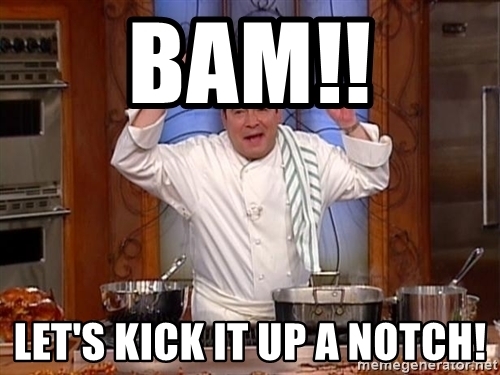11 Tips On How to Write Better Blog Posts

Word on the street is true: everyone and their mom does have a blog these days. And when you’re writing for business, it can be pretty dispiriting to see amazing content cranked out by bestselling authors, influencers, and huge content machines in your industry. After all, you’re not on the bestseller list and you don’t have an army of industry veterans cranking out content.
Instead, you have a passion for helping your customers and people in your industry—and not a lot of time to devote solely to your blog. But you still have to be producing high-quality content that will compete for people’s attention. It’s an equation that just doesn’t add up!

Until now, that is. If you’ve got the bones of high-quality content — some good ideas and solid writing — you’re well on your way. To take that post from good to great, we’ve dipped into our arsenal of pro tips. These are 11 tips on how to write better blog posts that pack a huge punch. They’ll help you understand how to write better blog posts without spending years perfecting craft.
Because the truth is that good content is more than just good writing. It’s about the best way to present your topics, the best way to hold reader interest and the best way to impart wisdom to readers. The tips you’re about to read aren’t shortcuts; they’re focal points for you to spend strategic energy to get those things to happen. Let’s do it.
Organization Tips to Up Your Game
Before you even start writing, there are things you can do to create better, more interesting blog posts. Taking a few extra minutes to suss out the details will make for a more readable, more structured post. Readers want to be able to skim through posts, immediately understand their points and put their new knowledge to use right away. These tips will help you cater to those desires.
1. Outline, outline, outline
If you aren’t already making short outlines for your blog post, you need to start. They’re a great way to ensure that your piece is engaging from top to bottom without much-added effort. You should keep your outlines brief, and focus on driving home the message: why is your piece relevant?
Once you’ve sketched out your thesis and a couple of supporting points, skim over. Two big things to look for are:
- Logical flow. Is there a clear progression from A to B to C?
- Overlapping points. Does any section reiterate what’s in another section?
If you have flow problems, reshuffle your points. Try thinking of the outline as a flowchart that takes your reader through a topic. (It might even help to draw that chart out.) Can you get from point A to B to C just using the lines and points on the chart as they’re connected? Or, try pretending you’re explaining the topic to a friend. Do you find yourself doubling back to explain something you missed? Move that point earlier!
If you have overlapping points, simply cut out the material that overlaps in one of the sections. Look for phrases that are similar or lengthy section intros. Saying the same thing too many times is a surefire way to bore a reader.
2. Titles: A minute to learn, a lifetime to master
We all know that a good title can drive views. Case in point: clickbait.

(Source)
But coming up with good titles is nowhere near as easy as BuzzFeed would have you think. We wish there were a magic formula to come up with an engaging, informative title, but there isn’t. There are some tips that we can give you to help make your titles better, though:
- Titles should be medium length. “X Ways to Write More Interesting Blog Posts.”
- Wherever possible, titles should highlight something controversial about your post. “Trying To Write A Good Blog Post? Spend Less Time Writing.”
- Titles can — and should — involve wordplay or puns. “How To Write The Blog Postest With The Mostest.”
- Make your title intriguing, but don’t be misleading. “Writing Better Blogs: It’s Easier Than You Think.” vs. “Writing Better Blog Posts Is Actually Really Easy.”
- Highlight numbers or examples if you use them. “X Tips For Quicker And Easier Blog Posts.”
- Be provocative, not sensationalist and annoying. “The Key To Better Blog Posts Isn’t Your Writing.” vs. “5 Never-Before-Seen Tactics for Writing The Best Blog Posts in the World – Number 4 Will Shock You.“
- Use high-intensity adjectives rather than “really” or “very.” “Really Easy Blog Posts in X Simple Steps.” vs. “Effortless Blog Posts in X Simple Steps.”
- Be creative. “How to Throw Your Bad Blog Posting Days in the Garbage Disposal and Never Look Back.”
As you write more and start to feel out what types of titles work best from your posts, keep a running list of title formats. There are some that just won’t work for some ideas (uhh… the postest with the mostest??) but chances are one format will fit for any given post. When you’re stuck on coming up for a good title, return to your list and give yourself five minutes to brainstorm five ideas — the combination of time pressure and examples could be what you need to spark something.
3. Subtitles bring it home
Subtitles are just as important as titles, but they serve a different purpose. Where titles are to grab your readers’ attention, subtitles are a tool to make posts easier to read and skim. Subtitles should be highly informative and denote what each section is about — but don’t be afraid to get creative.
Whatever you do, it’s not enough to simply slap on a bunch of subtitles and call it a day. Try taking a few minutes after you’ve finished a draft and concentrating on coming up with good section headers. Pro-tip: ask yourself if you would understand what your post is explaining using just subtitles alone. If you can’t, they aren’t descriptive enough.
Narrative Ideas To Engage Your Readers
Organization is one thing, narrative is another. A strong thesis will pull a reader through a post and make your content more compelling. Writing for marketing and writing for business are different from writing fiction, certainly. But that doesn’t mean abandoning narrative. Narrative elements should draw cohesion into your piece, not make them into a fairy tale.
4. Intros are your one chance at a good first impression
You click on a post, start to skim and the intro is so dry or so jumbled or so obviously written as marketing that you immediately exit the tab and never think about that post again. Sound familiar?
To avoid that in your own work, spend more time on the intro than you think you should. It can be easy to just breeze into the piece, but that generally lands you with a crappy intro. Try:
- Starting with a gripping anecdote.
- Opening with a controversial statement.
- Keeping your intros short and concise.
- Opening with a common problem and presenting your article as the solution.
Meanwhile, some things to avoid:
- Presenting a grand, sweeping statement as your basis for writing. “All marketers love data!!!”
- Skipping straight to the thesis and providing no narrative hook.
- Asking too many rhetorical questions.
- Leaving your readers without a rock solid understanding of the piece and what they’ll learn from it.
Just like we recommend you keep a list of types of titles, you might want to keep a list of really great introductions. If you find that you really like pieces that open with a story, go for it. If you love things that stir controversy, perfect that.
5. Be honest
When you’re writing as marketing, there is a tendency to, well, sell your solution. It’s the downfall of many otherwise good blogs — instead of hosting readable content, their posts end up sounding like marketing robots.

(Source)
Try taking a more direct, honest tone. Your readers want to see that you empathize with their problems — that you’ve been there and you know that your solution works. This means you have to reframe your blog post to be primarily about your expertise and not about your product. Make sure your advice is good, genuine, and reader-, not product-, focused.
6. Use someone else’s narrative
A quick way to make a great blog post is simply to interview someone smarter than you and let everyone know what they think. Not only will it connect you with the drivers of your industry, it will also be one of the easier posts you write. The keys to a successful interview post are:
- Brainstorm insightful questions. Nobody wants to know how someone got into their industry, but everyone wants to know the lessons learned that made that person successful. Avoid generic questions that are answered elsewhere, and use the interview as a chance to really pick someone’s brain.
- Get supplementary materials. Does someone talk about an amazing org chart they made? How they rearranged their office? The 75 logo prototypes they went through? Follow up and ask for visuals — it will make for a juicier post.
- Make your interviewee sound like a genius. Even the smoothest talkers are going to jumble up a little bit in an interview. Use your editorial hand to sand away any rough edges and make your interviewee sound like a genius. When you run your post by them prior to publishing, they’ll love how good they sound. And, more importantly, it will read more easily.
- Don’t make it too fancy. If you really want to have a quick and easy interview, just post the interview as an interview. Sure, making it into a full-fledged blog post with a narrative and embedded quotes can work really well, but if you don’t have the time, a Q&A style is just as good.
Bonus: when you are interviewing someone, chances are they’ll help you promote your piece, because it’s their words getting spread out there. That can bring up your ROI for the post dramatically.
Beyond Writing: Elements That Kick Your Posts Up A Notch
If there’s one chef that can teach us anything about making our content better, it’s Emeril Lagasse, known for his catchphrase:

Emeril knows best. | Source
When did Emeril say this? Not when he was doing the basics, but when he was adding spices and flavor. In blog posts, your writing is like the chicken or the pasta that makes the base of the satisfying dish. But all the extra elements we’re about to talk about are the spice: they’re what make your reader sit up and take notice — and finish the post wanting more.
7. Visuals are your friend
Blog posts have to be more than just a wall of text, and the easiest way to break things up is to throw in a few simple visuals. Maybe it’s a meme, maybe it’s a simple graph, maybe it’s a Dilbert comic. Whatever it is, that break in words functions in a couple of different ways.
First, they provide time for the reader to digest. If you’re bombarding a reader with a lot of information, giving a visual helps them take a breather and think about what they’ve just read. It also makes the piece less intimidating and encourages a reader to keep scrolling — something a wall of text sure doesn’t do.

Great for a house, horrible for a blog post. (Source)
Pictures and charts can also be a great way to replace text altogether. When you have a graph or a piece of data viz, that can cut down your word count while giving the reader the same — if not more — information.
8. Embeds hook the reader
Another way to cut down on words and replace them with a more engaging element is by using embeddable tools. When appropriate, adding a widget can make your post easier to understand and more interesting for readers.
Embeds ask your readers to literally interact with the article: they can play with different scenarios and put numbers or factors relevant to them into the equation. (Literally.) This makes people feel more connected to what you’re writing about, and adds a fun element that is a break from your standard tech content.
9. Your post should be a callout post
An incredibly quick way to break up text and make your post more interesting is to pull out quotes to offset. Not only does this give a visual interest, it also helps drive home the key points of your piece. When you have something you want to emphasize, go ahead and stick it in a quote block or callout.
You can also do this for the points that are going to stir up a little controversy in your post. If you know that you’re taking a stance that not everyone is going to agree with, highlighting it can bring a little more fire to your post with almost 0 time added. This is a trick that’s used in newspapers and magazines, and one that you should definitely borrow.
Don’t Stop After You Hit Publish
Interesting blog posts don’t pop up out of nowhere and posts are only as good as their ideas. There are probably a million things that you could blog about or want to blog about, but even then you have to know which ideas your audience will find interesting. Here are a couple of tips to keep the flow of good ideas coming.
10. Analytics
Use your blog analytics to learn what drives traffic to your blog and which content your readers enjoy. For every post that crushed it on your blog, there are five more waiting to happen. Because blog posts are so short, a successful post can easily spawn another and another — conversation is never finished. When you find a successful post, ask:
- What about this post was different than my other content?
- What are closely related topics I haven’t yet covered?
- How much did I change up my style or format from my usual?
- Are there any areas that weren’t fully explained in the post? Can those stand alone?
- What were the keywords I targeted on this post and what are related keywords?
Use these as a jumping off point to extend your discussion around topics that your readers are into. As you post more and more, you’ll have a better understanding of what styles and topics your readers like. This doesn’t mean you should stop branching out and trying new things, but it’s key to keeping the ball rolling.
11. Comments
The comments section is your best friend. Whether it’s a comments discussion on your blog or a comments discussion on a similar topic on Growth Hackers, interesting ideas breed when interested people come together and start discussing things. Take this comment on an AdEspresso post about Facebook video ads:

It’s practically a post idea in and of itself. The AdEspresso blog could make a comparison post between the three types of ads to help people like Jerome decide what types of ads are best for their businesses.
Use these comments to your advantage, both the ones on your blog post and any similar discussions on the web. Keep a document full of good questions, sparks of insight or points of contention from posters, and refer back to it when you’re ideating. If you want to get really fancy, you can cross-reference this with the list of topics from your blog analytics to hit home with your audience.
You Can Go Your Own Way
As you’ve probably guessed by now, there’s no magic formula to write amazing blog posts. If there were, everyone would be churning out fantastic content day after day after day. Instead, there are tips you can learn and tools you can use to tighten up your blog posts until you’re consistently producing good content.
But at the end of the day, what matters most is what works for your business. If clickbait titles are really getting people to read through posts, don’t stop using them because we said so. If you would never dream of using a Dilbert comic in your business’s posts, then don’t do it! Figure out the tricks that will get you consistent results from your content marketing.
